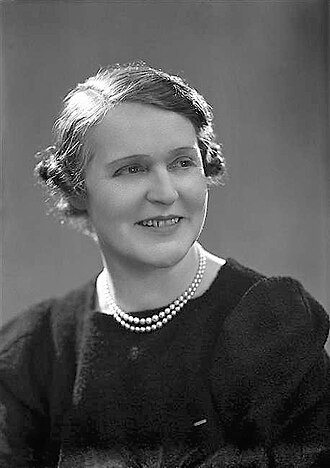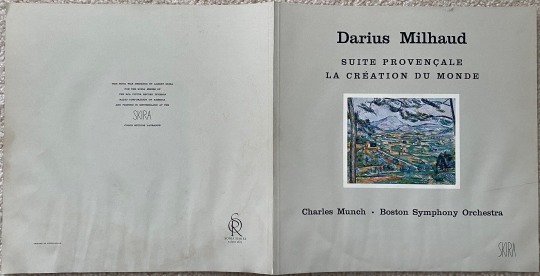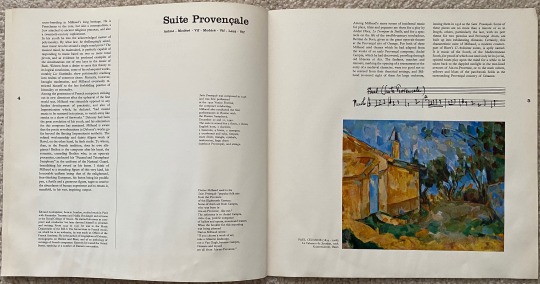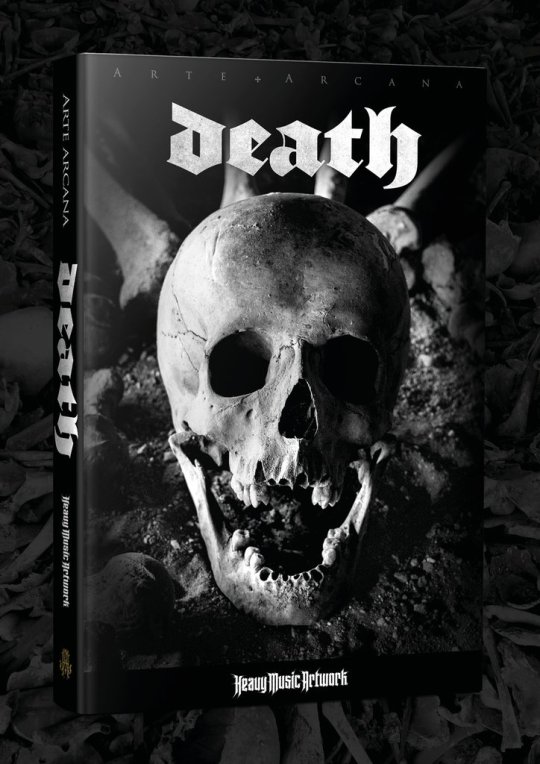#tailleferre
Explore tagged Tumblr posts
Text
CD review — Trio Colores: "En Couleur", works by Camille, Saint-Saëns, Maurice Ravel, Germaine Tailleferre, Claude Debussy, and Darius Milhaud, arranged for mallet percussion trio Blog post #671
#rolfsmblog#cdreview#review#classicalmusic#saint-saens#ravel#tailleferre#debussy#milhaud#percussion#triocolores#marimba#vibraphone#transcription
0 notes
Text
Germaine Tailleferre (1892-1983)
2 notes
·
View notes
Text


Plaque en hommage à : Germaine Tailleferre
Type : Lieu de résidence
Adresse : 87 rue d'Assas, 75006 Paris, France
Date de pose : Inconnue
Texte : Germaine TAILLEFERRE (1892-1983), Compositeur du Groupe des Six, A VECU ICI SES DERNIERES ANNEES
Quelques précisions : Germaine Tailleferre (1892-1983) est une musicienne française. Étudiant la musique au Conservatoire de Paris malgré l'opposition de son père, elle intègre le Groupe des Six, un petit groupe de compositeurs. Elle accomplit une prolifique carrière musicale, s'inscrivant dans le courant de l'impressionnisme, en dépit du manque de soutien de la part de ses deux époux successifs, et travaille avec et/ou pour des grands noms de la poésie et de la littérature comme Paul Fort, Paul Claudel et Paul Valéry. Elle doit quitter la France pendant la Seconde Guerre mondiale, n'y revenant qu'en 1946, mais elle continue à composer pendant toute sa vie, achevant sa dernière œuvre en 1981, deux ans avant sa mort.
#individuel#femmes#residence#artistes#musiciens#france#ile de france#paris#non datee#germaine tailleferre
0 notes
Text
i now have two new entries to add to my Crazy Shit Found at the Record Store list including (1) a recording of the original Star Wars soundtrack with no subtitle calling it episode iv or a new hope or even any reference to it being part of a series at all bc it's literally from 1977 where they were like "yeah we're just gonna make the one" and (2) an original broadway cast recording of West Side Story. yes chita rivera is there. yes it's from 1957. yes i'm still screaming about both of these.
#usually my Exciting Finds are like. insane classical music stuff that no one but me would care about anyway#like tailleferre on a les six record with jean cocteau narrating or a berio/swingle singers nyphil premiere or heifetz tchaik#but this is like semi-mainstream insanely cool stuff in pHENOMENAL CONDITION FOR BEING ALMOST 50 AND ALMOST 70 YRS OLD???#yes. i know. i'm a nerd. but let me have this one thing and then i'll calm down.#vio speaks
0 notes
Text
Mi crítica del concierto de Antonio Oyarzábal esta noche en el Espacio Turina.
#antonio oyarzábal#mana zucca#amy beach#florence price#mel bonis#germaine tailleferre#lili boulanger#emiliana de zubeldía#matilde salvador#lucija garuta#vitezslava#kaprálová#música#music
0 notes
Link
Germaine Tailleferre was a French composer and the only female member of the group of composers known as Les Six.
0 notes
Text









Ralph Waldo Emerson Barton (Ralph Barton), born August 14, 1891 was a popular American caricaturist of contemporary actors and other popular people. His works enjoyed great popularity in the 1920s and were considered to be the quintessence of the era.
A Short Biography of Ralph Barton by Bobb Edwards:
"Cartoonist, Illustrator. He was one of America's most famous artists of the 1920s. His stylish celebrity caricatures, playful yet not mocking, became synonymous with the "Jazz Age" and were widely influential. "It is not the caricaturist's job to be penetrating," he said. "It is his job to put down the figure a man cuts before his fellows in his attempt to conceal the writhings of his soul." Ralph Waldo Emerson Barton was born in Kansas City, Missouri. His mother was a portrait painter, and in his teens he sold cartoons to local newspapers. Following a brief early marriage and even briefer study at the Art Institute of Chicago, he settled in New York City in 1913 as a contributor to the humor magazine "Puck." Its editors sent him to France in 1915 to cover the Parisian home front during World War I; the experience turned him into an ardent Francophile and from then on he divided his time between Manhattan and Paris. His style showed the influence of Aubrey Beardsley before evolving into Art Deco sleekness. Barton's fame really took off after the war, when he began portraying stars of the arts and entertainment worlds, often in fanciful group portraits. He commanded $1500 per drawing for such leading publications as "Vanity Fair," and his designs appeared on silk scarves and other fashion accessories. In 1922 he caused a sensation with his intermission curtain for the popular Broadway revue "Chauve Souris," featuring 139 celebrity caricatures staring back at the audience. Barton was an artistic advisor for the magazine "The New Yorker" from its 1925 inception, and that same year he illustrated Anita Loos' classic novel "Gentlemen Prefer Blondes." He also photographed and directed a home movie version of "Camille" (1926), which combined staged scenes with shots of dozens of international notables clowning or just posing for Barton's camera, linked together with ironic intertitles. It survives as a fascinating curio. Barton's success masked a troubled personal life. Having "climbed out of the Kansas City mud" (as he was fond of saying), he reinvented himself as a foppish bon vivant who travelled widely and seemed to know everybody who was anybody. He was particularly good friends with Charlie Chaplin. But he was plagued by depression and a lack of self-esteem that drove him to reckless behavior. "The human soul would be a hideous object if it were possible to lay it bare," he once confessed. His three subsequent marriages, to model Anne Minnerly, actress Carlotta Monterey, and "Les Six" composer Germaine Tailleferre, all ended in divorce because of his compulsive philandering; he never got over Carlotta, who he claimed was the only woman he ever really loved. (She later married playwright Eugene O'Neill). The failure of his book "God's Country" (1929), a satirical view of American history through drawings, and the onset of the Depression marked a downturn in his popularity. In January 1931, Chaplin tried to raise Barton's spirits by inviting him as his traveling companion on an extended tour of Europe. The cartoonist started the journey well enough, but once they arrived in London he refused to leave their hotel and began exhibiting signs of paranoia. He returned home alone after only a few weeks. Fearing he was going insane, Barton shot himself in his Manhattan apartment shortly before his 40th birthday. His suicide note read in part, "I have run from wife to wife, from house to house and from country to country in a ridiculous effort to escape from myself." He also left $35 to his housekeeper with a note apologizing that it was all he had. His ashes were returned to Kansas City, the hometown he proudly thought he had put behind him. Barton was quickly forgotten after his death; a few years later an original Barton caricature sold for $5. Renewed interest in his work began in the late 1960s."
3 notes
·
View notes
Text







Darius Milhaud: Suite Provençale / La Création du Monde (1962)
Sometimes I'll just flip through the classical music racks in my local record stores in search of a record that piques the curiosity, whether based on a semi-familiar work or composer, or because it simply "looks" interesting enough to take home for a spin.
Such was the case with this beautifully-packaged 1962 LP (complete) with 12-page booklet) boasting two ballets by French composer Darius Milhaud (1892–1974), as performed by the Boston Symphony Orchestra, conducted by Charles Munch.
Acclaimed for his prolific experimentation, Milhaud studied at the Paris Conservatoire and rose to fame with 'Les Six': a group of young composers who broke with Romanticism and Impressionism in search of a more direct and distinctively French musical idiom. (*)
Milhaud was introduced to jazz during a trip to London, in 1920, and a subsequent trip to America, allowed him to experience "authentic jazz on the streets of Harlem," which in turn made an even greater impression and inspired La Création du Monde in 1923.
Based on a libretto by Blaise Cendrars detailing the creation of the world through the perspective of African folk mythology, this is a 15-minute ballet in six parts, each of which explores a daring fusion of the classical and jazz realms.
Personally, I heard some Tchaikovsky and Stravinsky in the somber, dramatic first few minutes, but once the jazzier horns and energized piano runs arrived, the piece evoked George Gershwin's Rhapsody in Blue, only here's the catch: Milhaud's composition predated Gershwin's far-more-famous work by about a year!
By contrast, 1936's Suite Provençale (which actually comes first, on side A), drew inspiration from traditional folk melodies (including themes by the Baroque composer André Campra) heard in the South of France.
Powered by the full orchestra, the piece is exuberant at the start, but soon settles down into a more contemplative mood, adopts dance-like qualities and then turns melancholy before resuming a fuller, bolder attack on its way to a triumphant finale.
To be honest, both works are a little too joyful, upbeat, and just plain "happy" for a miserable bastard like me, but I can see why more committed classical music audiences, with knowledge beyond the core repertoire still embrace Milhaud's oeuvre.
* The other members of 'Les Six' were Georges Auric (1899–1983), Louis Durey (1888–1979), Arthur Honegger (1892–1955), Francis Poulenc (1899–1963), and Germaine Tailleferre (1892–1983).
More Classical Music: Béla Bartók’s The Miraculous Mandarin, Ludwig van Beethoven’s Piano Concerto No. 5, Aaron Copland’s Symphony No. 3, Claude Debussy’s Prélude à L'Après-Midi d’un Faune, George Frideric Handel’s Water Music, Gustav Holst’s The Planets, Franz Liszt’s Piano Sonata In B Minor, Moondog’s Moondog, Carl Orff’s Carmina Burana, Luciano Pavarotti’s Favorite Tenor Arias, Sergei Prokofiev’s The Love for Three Oranges, Dmitri Shostakovich’s Symphony No. 10, Igor Stravinsky’s The Rite of Spring, Pyotr Ilyich Tchaikovsky’s Symphony No. 6, Edgard Varèse’s Complete Works, Heitor Villa-Lobos’ Bachianas Brasileiras, Antonio Vivaldi’s Le Quattro Stagioni, Richard Wagner’s Der Ring Des Nibelungen, Xenakis’ Metastasis, Frank Zappa’s London Symphony Orchestra, Vol. 1, Various Artists’ 2001: A Space Odyssey, Phases of the Moon.
1 note
·
View note
Text
Minori: Why don't you respond to my messages? :(
Shiho: I have absolutely nothing to say to "Germaine Tailleferre is really hot for a dead composer!" You know?
5 notes
·
View notes
Text

In Arte Arcana Death 105 awesome artists share their visions of death, mortality, memento mori, Hades, skull & bones, graveyards, and related subjects.
Featured artists:
Adam Chiodo, Agustin S. Lobos, Alan Lathwell, Alcides Burn, Alejandro Blasi, Alejandro Colucci, Alex Eckman-Lawn, Andrej Bartulović, Andrzej Kuziola, Angelo Roccagli, Ardha Lepa, Artur Szolc, Augusto Peixoto, Bahrull Marta, Benjamin A Vierling, Björn Gooßes, Blacksshark, Cadence Bennett, Caleb Dickenson, Camille Alquier, Camille Murgue, Candice Angélini, Christina Dressel, Christine Moren, Christophe Prades, Cláudio "Bharaduur" Moreira, Cyril Lawniczak, Daniel Bollans, Daniel Francisco, Daniel Valencia, Danielle Masek, David Berbel, Dávid Busai, David Ocampo, Declan Tiger, Devil-M, Devinez, Dis-Art Design Hans, Douglas Alvarenga, Drowned Orange, Galen Baudhuin, Gavin Sodo, Geert Kroes, George Martzoukos, George Patsouras, GodLikeIkons, Alexey Sivitsky, Heather Rose, Heidi Tailleferr, Ikosidio, Theopisti Tiftikoglou, Isabel Maria Gonzalez, Jamie Christ, Jan Maly, Jesus Lhysta, John Paul Whetzel, Josh Beamish, Kacper Gilka, Ken Coleman, Ken Jeremiassen, Ken Miller, Kon Markogiannis, Kornel Kwieciński, Le Nevralgie Costanti, Leon Bakalarz, Ludovic Robin, Márcio Blasphemator, Michael Peter Stokes, Michele Sanguin, Mike Redman, Mothmeister, Nestor Avalos, Nethern Temple Designs, Oswaldo Castillo, Parjo Surodilogo, Paul McCarroll, Paul Thureau, Paula Golemo, Rheblys, Roberto Toderico, Ruslan Stanchula, Ryan Clark, Sam Hayles, Scott Shellhamer, Sebastian Jerke, Shuel Duo, Simon Bossert, Sludgework Megan Umpleby, Steve Knerem, The Iron Parasite, Thomas Ewerhard, Timbul Cahyono, Timo Wuerz, Truly Lost, Violence Artwork Nanda Dika, Vladimir Smerdulak Chebakov, Vladislav Cadaversky, Waclaw Traier, Yannick Bouchard, Yuriy Skorohod.
A4 Portrait 210mm x 297mm (11.7inch x 8.3inch) Hardback Silk laminated dust jacket Over 232 pages 150gsm silk paper Limited to 1000
youtube
2 notes
·
View notes
Text
Germaine Tailleferre’s Valse Lente. Performed by Alexandre Tharaud, from the album “Autograph”. Published in 2013 by Erato.
0 notes
Text
youtube
Germaine Tailleferre (1892-1983) - La Rue Chagrin ·
Art Nouveau Ensemble :
Cristina Ariagno, piano · · Claire Gouton, vocals
2 notes
·
View notes
Text

I’m exciting to join pianist Quynh Nguyen for a fun interview on the latest One Symphony episode!
https://open.spotify.com/show/5m2vuUKQPkAMfEprbCCTQx?si=f2cb729da03f4d28
In this episode of One Symphony, conductor Devin Patrick Hughes interviews internationally renowned pianist Quynh Nguyen, exploring her remarkable journey in music. Born in post-war Vietnam, Nguyen's path has been shaped by her family legacy, global influences, and dedication to her craft. From her early beginnings at the Hanoi Conservatory to her studies in Moscow, Paris, and the United States, Nguyen's story exemplifies perseverance and the power of music to transcend boundaries. The interview examines Nguyen's direct connections with French composer Olivier Messiaen and studying with his wife Yvonne Loriod, her respect for Germaine Tailleferre's resilience, and her collaboration with Paul Chihara on his Concerto Fantasy for Piano and Orchestra. Nguyen also explores music’s capability to promote peace between nations in her touching final remarks.
#pianist #Classicalmusic #concerto #orchestra #music #podcast
#symphony#orchestra#conductor#classical music#music education#podcast#composer#film music#piano#concerto
0 notes
Text
youtube
Germaine Tailleferre (1892 - 1983) - Quatuor à Cordes (1917 - 1919), performed by Fanny Mendelssohn Quartet
0 notes